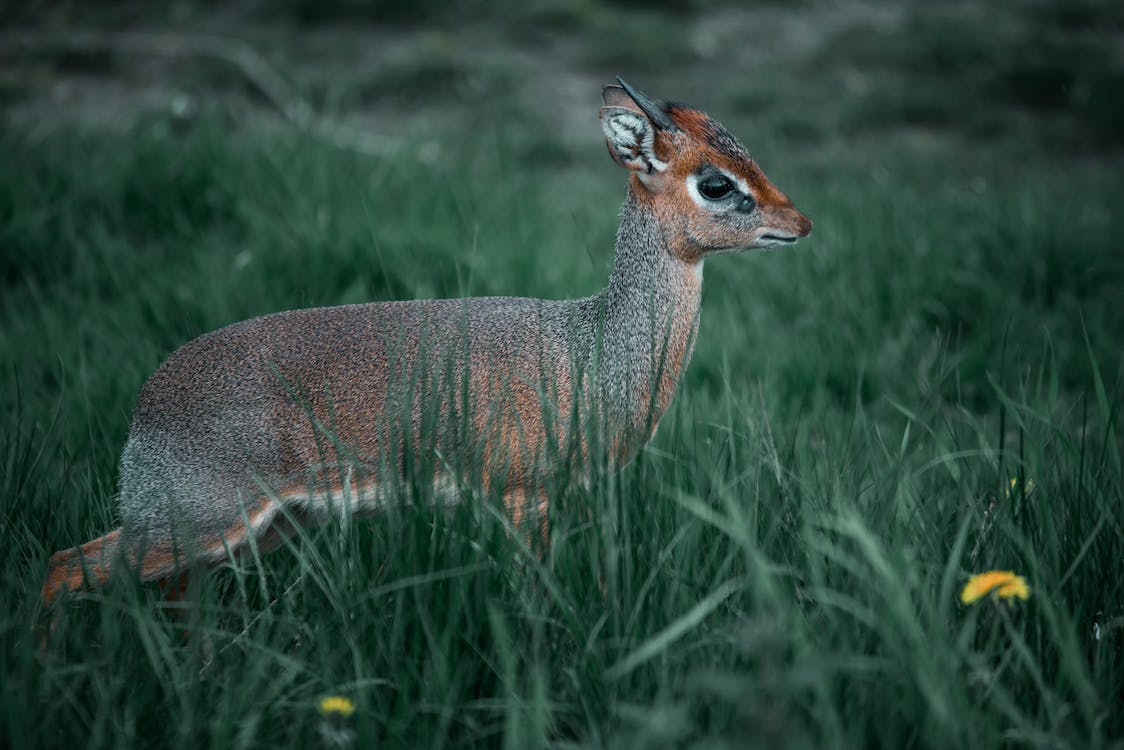It is one of the world’s smallest antelope whose color may vary depending on the habitat, but generally have a yellowish-gray to reddish-brown back with a whitish belly. Males possess a stout horn, often hidden in a hair tuft on their forehead. Frequents savannas and arid scrubland forests, foraging foliage, fruits, berries, and shoots. One remarkable and distinguishable adaptation of the species is its elongated snout, which is an effective cooling mechanism, preventing them from overheating and decreasing their need for water.
Read further to know more about Kirk’s Dikdik.
What is a Kirk’s Dik-dik?
Kirk’s Dikdik is a tiny antelope (Madoqua kirkii) belonging to the family Bovidae. It is an Eastern Africa native that can live in an array of conditions, as long as there is a lot of vegetation available for food and cover. When threatened, they run at high speeds, reaching 40 to 42 kilometers per hour and darting in a zigzag pattern. The species got its name from the alarm call they produce, characterized by a whistling or wheezing “dik-dik” or “zik-zik” sound. Despite their best efforts, they often fall prey and serve as an essential food source for many predators, such as leopards, lions, cheetahs, hyenas, crocodiles, and pythons.
Its seven levels of classification are as follows:
Kingdom: Animalia
Phylum: Chordata
Class: Mammalia
Order: Artiodactyla
Family: Bovidae
Genus: Madoqua
Species: M. kirkii
Kirk’s Dik-dik Physical Description
Kirk’s Dik-diks are small antelopes, one of the smallest in the world, growing from 23 to 24 inches or 58.4 to 60.9 centimeters and weighing 4.98 to 5.44 kilograms or 11 to 12 pounds.
The coat ranges from yellowish-brown to reddish-brown above, with white underparts, while flanks and limbs are tan. Hind limbs resemble that of a hare, being relatively larger than the front legs. The eyes are beautiful, large eyes, accentuated by a white ring. Prominent preorbital glands are also observed. Only males sport a stout horn, either backward or straight, often hidden in a hair tuft on their forehead. However, females are relatively larger.
The most recognizable feature of Kirk’s Dik-dik is its elongated snout, appearing like a proboscis. It is an enlarged nasal chamber that serves as an effective cooling mechanism. It is supplied with venous blood, cooled efficiently through nasal panting before it is pumped back to the body, helping regulate body temperature and minimizing water loss in the air they exhale. This feature, alongside other conserving measures and its nocturnal behavior, allows Kirk’s Dik-dik to thrive in an array of conditions.
Where can they be spotted?
Kirk’s Dik-diks are native to eastern and southwestern Africa, occurring in Somalia to Tanzania, and Namibia to Angola. These antelopes frequent savannas, scrubland forests, and arid biotic zones, brimmed with ample covers but sans taller grasses or vegetation. Preferable habitats for this species are characterized by a variety of open understories at eye level. They may perform necessary movements should vegetation grow too high and block their view.
Interesting Facts You Should Know About the Kirk’s Dik-dik
Kirk’s Dik-diks are herbivorous antelopes, feeding mainly on various foliage, fruits, berries, shoots. Given their unique adaptations, they don’t need much water and depend on vegetation as its source.
However, these antelopes are fussy with the food they eat, preferring those plants that can be quickly digested. These food items include foliage and fruits abundant with water and nutrients, but relatively low in cellulose and fiber. With the given diet, Kirk’s Dik-diks produce the driest and most concentrated urine droppings among all ungulates species.
Kirk’s Dik-diks are monogamous and will form life-long bonds with their partners. The pair maintains a territory, where they can be seen singly or together. They are extremely territorial, and will mark their range using a dark, sticky fluid excreted from the glands between their hooves and just below their eyes.
These antelopes are nocturnal, feeding in the night while seeking refuge under shade during the hottest parts of the day. While they are swift runners, they prefer to hide when threatened or in danger, rather than flee from their predators. However, if detected, they run fast in a zigzag pattern, while producing a “dik-dik” or “zik-zik” alarm call to alert their pair or agitate predators. The given alarm call earned them their name.
The breeding of these antelopes may occur twice a year, with the female Kirk’s Dikdik giving birth to one calf after a 5 to 6-month gestation period. The offspring will stay concealed with the mother for another 2 to 3 weeks, nursing them for up to 6 weeks. The juvenile will reach their full-grown size about seven months after birth and will have to move or be chased out of the parent’s territory once a new calf is born.
Kirk’s Dik-diks’ population size faces no significant threat at the moment. However, they are being hunted for their bones and skins. Bones from their legs and feet are often used in traditional jewelry, while their skins are used for making gloves, with one hide only producing one glove. Despite this, their number appears to be stable, and they are currently classified as Least Concern (LC) under the IUCN Red List of Threatened Species.
WILDLIFE PARKS AND RESERVES WHERE THIS SPECIES IS FOUND:
NAMIBIA
